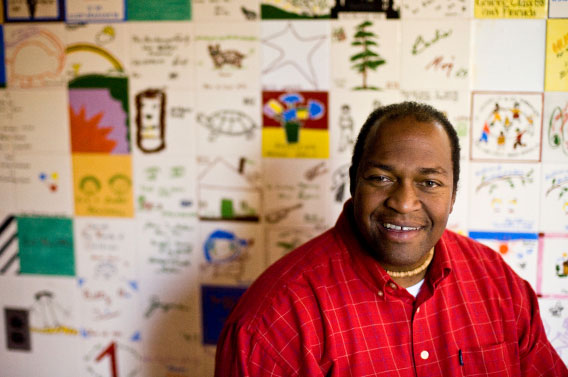The Joke Is the Message
Chip Gidney analyzes cartoons for clues about what humor children understand and what it says about their developing minds
By Helene Ragovin
Calvin “Chip” Gidney spends a good part of his days analyzing the interactions of animated characters with names like “Chowder” and “Captain Huggyface.”
It’s not for fun—he is studying how children understand and appreciate TV humor as part of the Children’s Television Project, a research endeavor that examines children’s TV programming from a developmental perspective. “I try to get people to think a little more critically about the images that are passed on,” says Gidney, an associate professor in the Eliot-Pearson Department of Child Development.

“How can we promote media literacy so children won’t passively accept these images and will think critically?” asks Calvin “Chip” Gidney, who gave the Lerman-Neubauer Lecture on April 23. Photo: Alonso Nichols
“It’s impossible to underestimate the effect of television on different aspects of children’s development,” he says. Television, Gidney stresses, “is the most globally disseminated storytelling medium in human history.” It has become one of the most ubiquitous influences on children around the world—in both developed and developing nations—in terms of language development and the formation of attitudes and beliefs.
Gidney cites statistics that are unlikely to surprise: approximately 99 percent of American youth have one or more televisions in their homes, and 70 percent have TVs in their bedrooms. One 2005 national survey showed that children ages 8 to 18 spend more time watching TV than pursuing any other activity.
What’s the effect of all this? That depends, says Gidney, whose research looks at the intersection of language and culture. “Television is just a tool,” he says. “It has the power to be a force for some negative things; it also is a very powerful educational force.”
Chief among the devices that TV writers and programmers use to relay messages, especially to children, is humor. Gidney and his research assistants have been dissecting the humor of children’s animated television shows, and from a developmental perspective asking the question: What aspects of the humor are children able to understand?
What makes children laugh, at the most elemental level, is incongruity—the occurrence of normally incompatible elements. In fact, that’s what lies behind most adult humor, too. And, as with adults, children’s humor helps them deal with psychological discomfort—for example, the appearance of “potty humor” at the stage when children begin to gain control of their bodily functions.
To this end, Gidney’s team has been watching segments of cartoons and cataloging the content as it’s used for humorous effect. That involves the detailed task of watching cartoons multiple times and logging what the researchers see and hear second by second: noting visual cues, such as how the characters are drawn; vocal qualities of the characters; dialect and language choices; background music; sound effects and the rhetorical strategies employed by the writers.
Understanding humor is an interdisciplinary process, stretching across multiple domains: cognitive, linguistic, physical, social and emotional. “Children take from all these areas based on their own cultural assumptions,” Gidney says.
Humor in children progresses along a developmental continuum: a 3-year-old will howl at the idea of mismatched objects, for example, but an appreciation of sarcasm and irony won’t appear until at least after age 8.
It is also through humor that children incorporate messages about social norms, Gidney says. In most TV programming, children are offered subtle—and often, not-so-subtle—cues about expected behaviors related to gender, race, ethnicity and other areas, and told that it’s funny when characters flout those norms. For example, think of the “humorous” cartoon stereotype of the brainy, but unattractive, girl, such as Gretchen on the Disney series Recess or Velma from Scooby-Doo.
Gidney hopes this research, when completed, will speak to various constituencies, including teachers, parents and producers of children’s television. For producers, this would mean creating programs that are more in tune with children’s developmental levels and that promote social behavior. Gidney is already helping out in that arena: he is on the advisory board of the PBS children’s series Word Girl.
For teachers and parents, the lesson is more difficult. “How can educators harness television’s real important educational potential, while teaching children at the same time to be critical of the images they see?” Gidney asks. “For parents and other caregivers, how can we promote media literacy so children won’t passively accept these images and will think critically?”
Helene Ragovin can be reached at helene.ragovin@tufts.edu.


